High Spatiotemporal Remote Sensing Images Reveal Spatial Heterogeneity Details of Soil Organic Matter
Abstract
1. Introduction
2. Materials and Methods
2.1. Study Area
2.2. Soil Sampling and Analysis
2.3. Remote Sensing Image Acquisition and Preprocessing
2.3.1. Landsat-8/Landsat-9 OLI Image
2.3.2. Sentinel-2 MSI Image
2.3.3. Gaofen-6 PMS Image
2.4. SOM Prediction Model
2.5. Model Evaluation and Analysis
2.6. Technology Framework
3. Results
3.1. Descriptive Statistics of SOM Content in Soil Samples
3.2. Predicting SOM Accuracy for Single-Phase Images
3.3. Predicting SOM Accuracy for Multi-Phase Synthetic Images
3.4. Absolute Errors in SOM Predictions for Different Ranges
3.5. SOM Prediction Maps
4. Discussion
4.1. The Role of High Spatiotemporal Remote Sensing Images for SOM Prediction
4.2. Single Satellite Prediction SOM Comparison
4.3. Importance and Application of SOM Mapping at the Meter-Level
4.4. Limitations and Prospects
5. Conclusions
Author Contributions
Funding
Institutional Review Board Statement
Informed Consent Statement
Data Availability Statement
Conflicts of Interest
References
- Franzluebbers, A.J. Soil Organic Matter Stratification Ratio as an Indicator of Soil Quality. Soil Tillage Res. 2002, 66, 95–106. [Google Scholar] [CrossRef]
- Rahmani, S.R.; Ackerson, J.P.; Schulze, D.; Adhikari, K.; Libohova, Z. Digital Mapping of Soil Organic Matter and Cation Exchange Capacity in a Low Relief Landscape Using LiDAR Data. Agronomy 2022, 12, 1338. [Google Scholar] [CrossRef]
- Nichols, J.D. Relation of Organic Carbon to Soil Properties and Climate in the Southern Great Plains. Soil Sci. Soc. Am. J. 1984, 48, 1382–1384. [Google Scholar] [CrossRef]
- Kuzyakov, Y.; Horwath, W.R.; Dorodnikov, M.; Blagodatskaya, E. Chapter Eight—Effects of Elevated CO2 in the Atmosphere on Soil C and N Turnover. In Developments in Soil Science; Horwath, W.R., Kuzyakov, Y., Eds.; Climate Change Impacts on Soil Processes and Ecosystem Properties; Elsevier: Amsterdam, The Netherlands, 2018; Volume 35, pp. 207–219. [Google Scholar]
- Liu, Z.; Yang, X.; Hubbard, K.G.; Lin, X. Maize Potential Yields and Yield Gaps in the Changing Climate of Northeast China. Glob. Chang. Biol. 2012, 18, 3441–3454. [Google Scholar] [CrossRef]
- Wang, X.; Li, S.; Wang, L.; Zheng, M.; Wang, Z.; Song, K. Effects of Cropland Reclamation on Soil Organic Carbon in China’s Black Soil Region over the Past 35 Years. Glob. Chang. Biol. 2023, 29, 5460–5477. [Google Scholar] [CrossRef] [PubMed]
- Orr, H.; Wilby, R.; McKenzie Hedger, M.; Brown, I. Climate Change in the Uplands: A UK Perspective on Safeguarding Regulatory Ecosystem Services. Clim. Res. 2008, 37, 77–98. [Google Scholar] [CrossRef]
- Zhou, T.; Geng, Y.; Chen, J.; Liu, M.; Haase, D.; Lausch, A. Mapping Soil Organic Carbon Content Using Multi-Source Remote Sensing Variables in the Heihe River Basin in China. Ecol. Indic. 2020, 114, 106288. [Google Scholar] [CrossRef]
- Guo, H.; He, G.; Jiang, W.; Yin, R.; Yan, L.; Leng, W. A Multi-Scale Water Extraction Convolutional Neural Network (MWEN) Method for GaoFen-1 Remote Sensing Images. ISPRS Int. J. Geo-Inf. 2020, 9, 189. [Google Scholar] [CrossRef]
- Ottoy, S.; De Vos, B.; Sindayihebura, A.; Hermy, M.; Van Orshoven, J. Assessing Soil Organic Carbon Stocks under Current and Potential Forest Cover Using Digital Soil Mapping and Spatial Generalisation. Ecol. Indic. 2017, 77, 139–150. [Google Scholar] [CrossRef]
- Liu, Q.; He, L.; Guo, L.; Wang, M.; Deng, D.; Lv, P.; Wang, R.; Jia, Z.; Hu, Z.; Wu, G.; et al. Digital Mapping of Soil Organic Carbon Density Using Newly Developed Bare Soil Spectral Indices and Deep Neural Network. Catena 2022, 219, 106603. [Google Scholar] [CrossRef]
- Demattê, J.A.M.; Alves, M.R.; Terra, F.D.S.; Bosquilia, R.W.D.; Fongaro, C.T.; Barros, P.P.D.S. Is It Possible to Classify Topsoil Texture Using a Sensor Located 800 Km Away from the Surface? Rev. Bras. Ciênc. Solo 2016, 40, e0150335. [Google Scholar] [CrossRef]
- Meng, X.; Bao, Y.; Liu, J.; Liu, H.; Zhang, X.; Zhang, Y.; Wang, P.; Tang, H.; Kong, F. Regional Soil Organic Carbon Prediction Model Based on a Discrete Wavelet Analysis of Hyperspectral Satellite Data. Int. J. Appl. Earth Obs. Geoinf. 2020, 89, 102111. [Google Scholar] [CrossRef]
- Chen, D.; Chang, N.; Xiao, J.; Zhou, Q.; Wu, W. Mapping Dynamics of Soil Organic Matter in Croplands with MODIS Data and Machine Learning Algorithms. Sci. Total Environ. 2019, 669, 844–855. [Google Scholar] [CrossRef]
- Ye, Z.; Sheng, Z.; Liu, X.; Ma, Y.; Wang, R.; Ding, S.; Liu, M.; Li, Z.; Wang, Q. Using Machine Learning Algorithms Based on GF-6 and Google Earth Engine to Predict and Map the Spatial Distribution of Soil Organic Matter Content. Sustainability 2021, 13, 14055. [Google Scholar] [CrossRef]
- Zhang, Z.; Lu, L.; Zhao, Y.; Wang, Y.; Wei, D.; Wu, X.; Ma, X. Recent Advances in Using Chinese Earth Observation Satellites for Remote Sensing of Vegetation. ISPRS J. Photogramm. Remote Sens. 2023, 195, 393–407. [Google Scholar] [CrossRef]
- Chen, F.; Zhang, W.; Song, Y.; Liu, L.; Wang, C. Comparison of Simulated Multispectral Reflectance among Four Sensors in Land Cover Classification. Remote Sens. 2023, 15, 2373. [Google Scholar] [CrossRef]
- Barsi, J.A.; Alhammoud, B.; Czapla-Myers, J.; Gascon, F.; Haque, M.O.; Kaewmanee, M.; Leigh, L.; Markham, B.L. Sentinel-2A MSI and Landsat-8 OLI Radiometric Cross Comparison over Desert Sites. Eur. J. Remote Sens. 2018, 51, 822–837. [Google Scholar] [CrossRef]
- Flood, N. Comparing Sentinel-2A and Landsat 7 and 8 Using Surface Reflectance over Australia. Remote Sens. 2017, 9, 659. [Google Scholar] [CrossRef]
- Dong, J.; Chen, Y.; Chen, X.; Xu, Q. Radiometric Cross-Calibration of Wide-Field-of-View Cameras Based on Gaofen-1/6 Satellite Synergistic Observations Using Landsat-8 Operational Land Imager Images: A Solution for Off-Nadir Wide-Field-of-View Associated Problems. Remote Sens. 2023, 15, 3851. [Google Scholar] [CrossRef]
- Guo, L.; Liu, Y.; He, H.; Lin, H.; Qiu, G.; Yang, W. Consistency Analysis of GF-1 and GF-6 Satellite Wide Field View Multi-Spectral Band Reflectance. Optik 2021, 231, 166414. [Google Scholar] [CrossRef]
- Li, R.; Wang, L.; Lu, Y. A Comparative Study on Intra-Annual Classification of Invasive Saltcedar with Landsat 8 and Landsat 9. Int. J. Remote Sens. 2023, 44, 2093–2114. [Google Scholar] [CrossRef]
- Shi, J.; Shen, Q.; Yao, Y.; Li, J.; Chen, F.; Wang, R.; Xu, W.; Gao, Z.; Wang, L.; Zhou, Y. Estimation of Chlorophyll-a Concentrations in Small Water Bodies: Comparison of Fused Gaofen-6 and Sentinel-2 Sensors. Remote Sens. 2022, 14, 229. [Google Scholar] [CrossRef]
- Xia, C.; Zhang, Y. Comparison of the Use of Landsat 8, Sentinel-2, and Gaofen-2 Images for Mapping Soil pH in Dehui, Northeastern China. Ecol. Inform. 2022, 70, 101705. [Google Scholar] [CrossRef]
- Zhang, M.; Lin, H. Wetland Classification Using Parcel-Level Ensemble Algorithm Based on Gaofen-6 Multispectral Imagery and Sentinel-1 Dataset. J. Hydrol. 2022, 606, 127462. [Google Scholar] [CrossRef]
- Li, Q.; Wang, L.; Fu, Y.; Lin, D.; Hou, M.; Li, X.; Hu, D.; Wang, Z. Transformation of Soil Organic Matter Subjected to Environmental Disturbance and Preservation of Organic Matter Bound to Soil Minerals: A Review. J. Soils Sediments 2023, 23, 1485–1500. [Google Scholar] [CrossRef]
- Hu, L.; Li, Q.; Yan, J.; Liu, C.; Zhong, J. Vegetation Restoration Facilitates Belowground Microbial Network Complexity and Recalcitrant Soil Organic Carbon Storage in Southwest China Karst Region. Sci. Total Environ. 2022, 820, 153137. [Google Scholar] [CrossRef]
- Chander, G.; Helder, D.L.; Aaron, D.; Mishra, N.; Shrestha, A.K. Assessment of Spectral, Misregistration, and Spatial Uncertainties Inherent in the Cross-Calibration Study. IEEE Trans. Geosci. Remote Sens. 2013, 51, 1282–1296. [Google Scholar] [CrossRef]
- Grimm, R.; Behrens, T.; Märker, M.; Elsenbeer, H. Soil Organic Carbon Concentrations and Stocks on Barro Colorado Island—Digital Soil Mapping Using Random Forests Analysis. Geoderma 2008, 146, 102–113. [Google Scholar] [CrossRef]
- Schulze, D.G.; Nagel, J.L.; Van Scoyoc, G.E.; Henderson, T.L.; Baumgardner, M.F.; Stott, D.E. Significance of Organic Matter in Determining Soil Colors. In Soil Color; Wiley: Hoboken, NJ, USA, 1993. [Google Scholar]
- Belgiu, M.; Drăguţ, L. Random Forest in Remote Sensing: A Review of Applications and Future Directions. ISPRS J. Photogramm. Remote Sens. 2016, 114, 24–31. [Google Scholar] [CrossRef]
- Gorelick, N.; Hancher, M.; Dixon, M.; Ilyushchenko, S.; Thau, D.; Moore, R. Google Earth Engine: Planetary-Scale Geospatial Analysis for Everyone. Remote Sens. Environ. 2017, 202, 18–27. [Google Scholar] [CrossRef]
- Hamzehpour, N.; Shafizadeh-Moghadam, H.; Valavi, R. Exploring the Driving Forces and Digital Mapping of Soil Organic Carbon Using Remote Sensing and Soil Texture. Catena 2019, 182, 104141. [Google Scholar] [CrossRef]
- Luo, C.; Zhang, W.; Zhang, X.; Liu, H. Mapping of Soil Organic Matter in a Typical Black Soil Area Using Landsat-8 Synthetic Images at Different Time Periods. Catena 2023, 231, 107336. [Google Scholar] [CrossRef]
- Meng, X.; Bao, Y.; Wang, Y.; Zhang, X.; Liu, H. An Advanced Soil Organic Carbon Content Prediction Model via Fused Temporal-Spatial-Spectral (TSS) Information Based on Machine Learning and Deep Learning Algorithms. Remote Sens. Environ. 2022, 280, 113166. [Google Scholar] [CrossRef]
- Palacios-Orueta, A.; Ustin, S.L. Remote Sensing of Soil Properties in the Santa Monica Mountains I. Spectral Analysis. Remote Sens. Environ. 1998, 65, 170–183. [Google Scholar] [CrossRef]
- Shepherd, K.D.; Walsh, M.G. Division S-8—Nutrient Management & Soil & Plant Analysis. Soil. Sci. Soc. Am. J. 2002, 66, 268–275. [Google Scholar]
- Dalal, R.C.; Henry, R.J. Simultaneous Determination of Moisture, Organic Carbon, and Total Nitrogen by Near Infrared Reflectance Spectrophotometry. Soil Sci. Soc. Am. J. 1986, 50, 120–123. [Google Scholar] [CrossRef]
- Dou, X.; Wang, X.; Liu, H.; Zhang, X.; Meng, L.; Pan, Y.; Yu, Z.; Cui, Y. Prediction of Soil Organic Matter Using Multi-Temporal Satellite Images in the Songnen Plain, China. Geoderma 2019, 356, 113896. [Google Scholar] [CrossRef]
- Luo, C.; Zhang, X.; Meng, X.; Zhu, H.; Ni, C.; Chen, M.; Liu, H. Regional Mapping of Soil Organic Matter Content Using Multitemporal Synthetic Landsat 8 Images in Google Earth Engine. Catena 2022, 209, 105842. [Google Scholar] [CrossRef]
- Niroumand-Jadidi, M.; Bovolo, F.; Bresciani, M.; Gege, P.; Giardino, C. Water Quality Retrieval from Landsat-9 (OLI-2) Imagery and Comparison to Sentinel-2. Remote Sens. 2022, 14, 4596. [Google Scholar] [CrossRef]
- Zeraatpisheh, M.; Jafari, A.; Bagheri Bodaghabadi, M.; Ayoubi, S.; Taghizadeh-Mehrjardi, R.; Toomanian, N.; Kerry, R.; Xu, M. Conventional and Digital Soil Mapping in Iran: Past, Present, and Future. Catena 2020, 188, 104424. [Google Scholar] [CrossRef]
- Wadoux, A.M.J.; Román Dobarco, M.; Malone, B.; Minasny, B.; McBratney, A.B.; Searle, R. Baseline High-Resolution Maps of Organic Carbon Content in Australian Soils. Sci. Data 2023, 10, 181. [Google Scholar] [CrossRef] [PubMed]
- Ahmad, U.; Sharma, L. A Review of Best Management Practices for Potato Crop Using Precision Agricultural Technologies. Smart Agric. Technol. 2023, 4, 100220. [Google Scholar] [CrossRef]
- Piedallu, C.; Pedersoli, E.; Chaste, E.; Morneau, F.; Seynave, I.; Gégout, J.-C. Optimal Resolution of Soil Properties Maps Varies According to Their Geographical Extent and Location. Geoderma 2022, 412, 115723. [Google Scholar] [CrossRef]
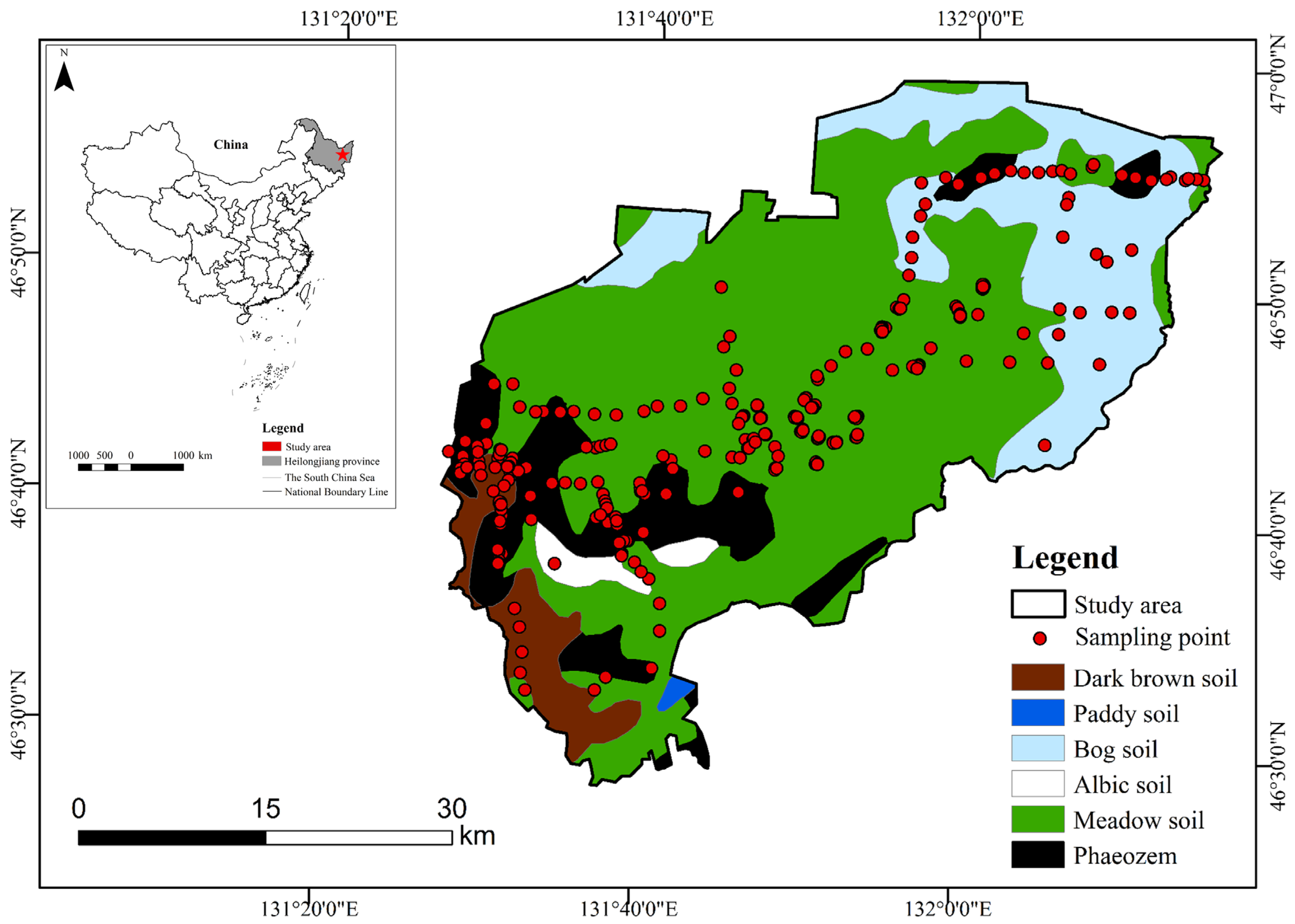
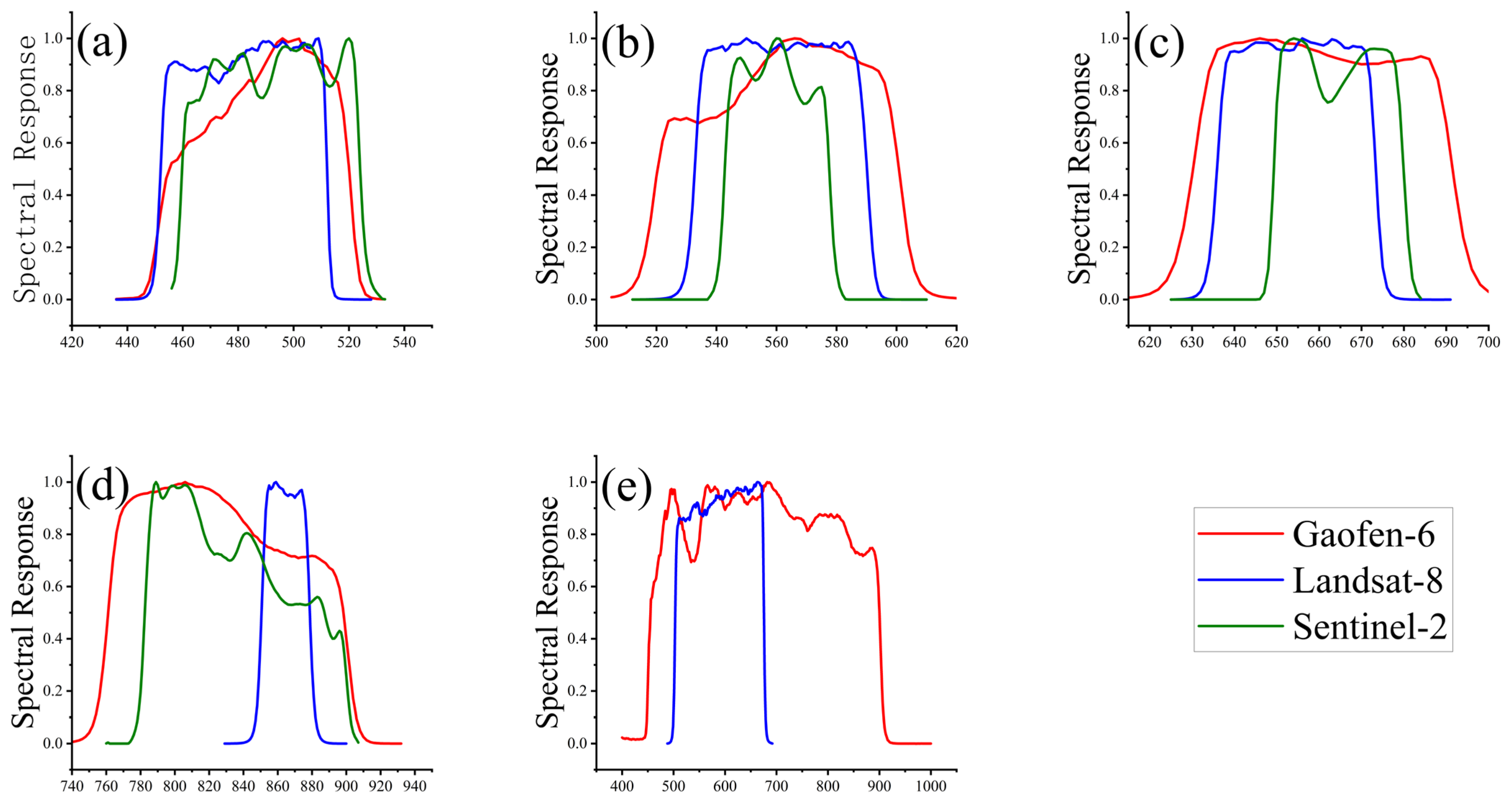
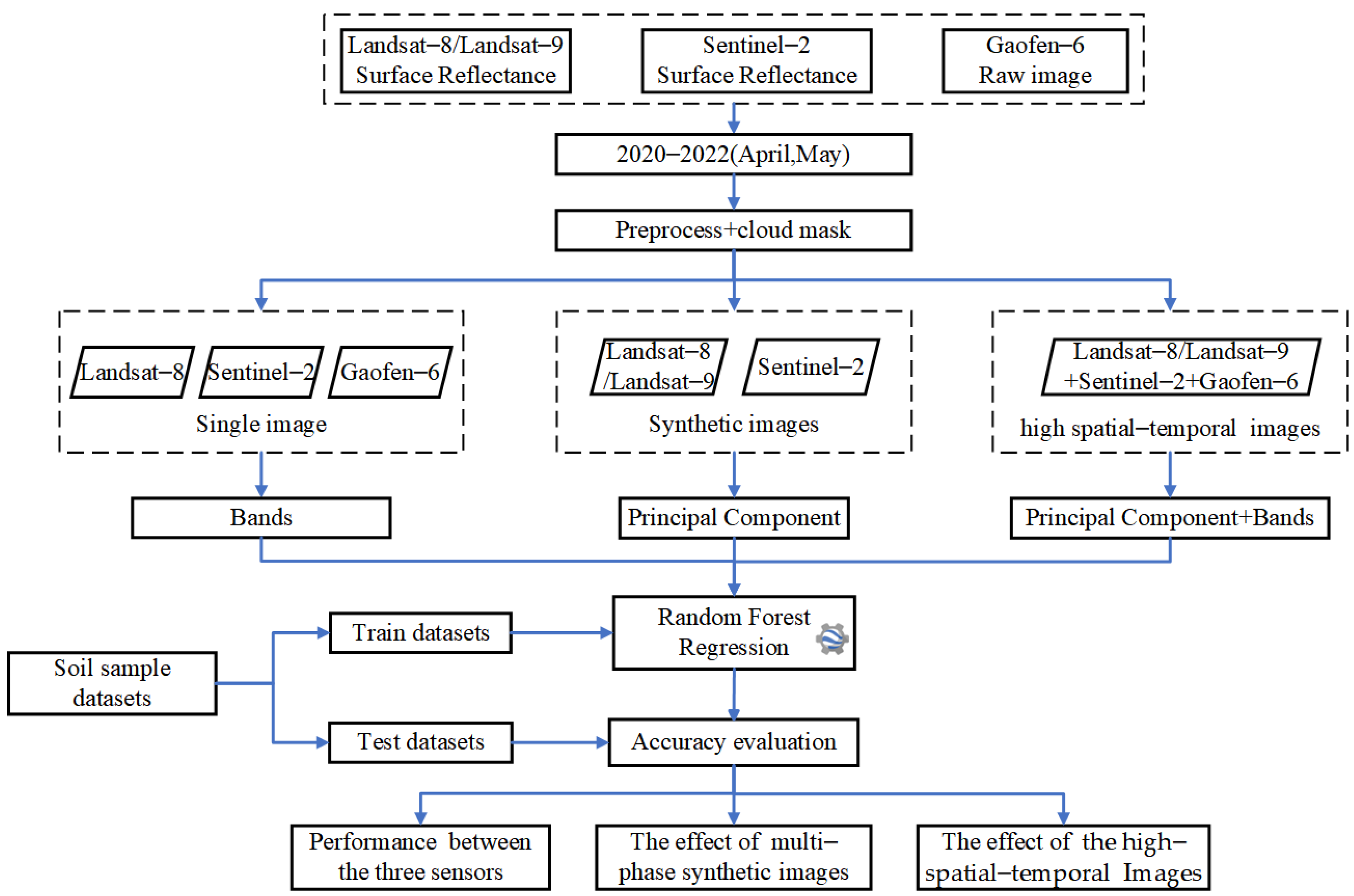
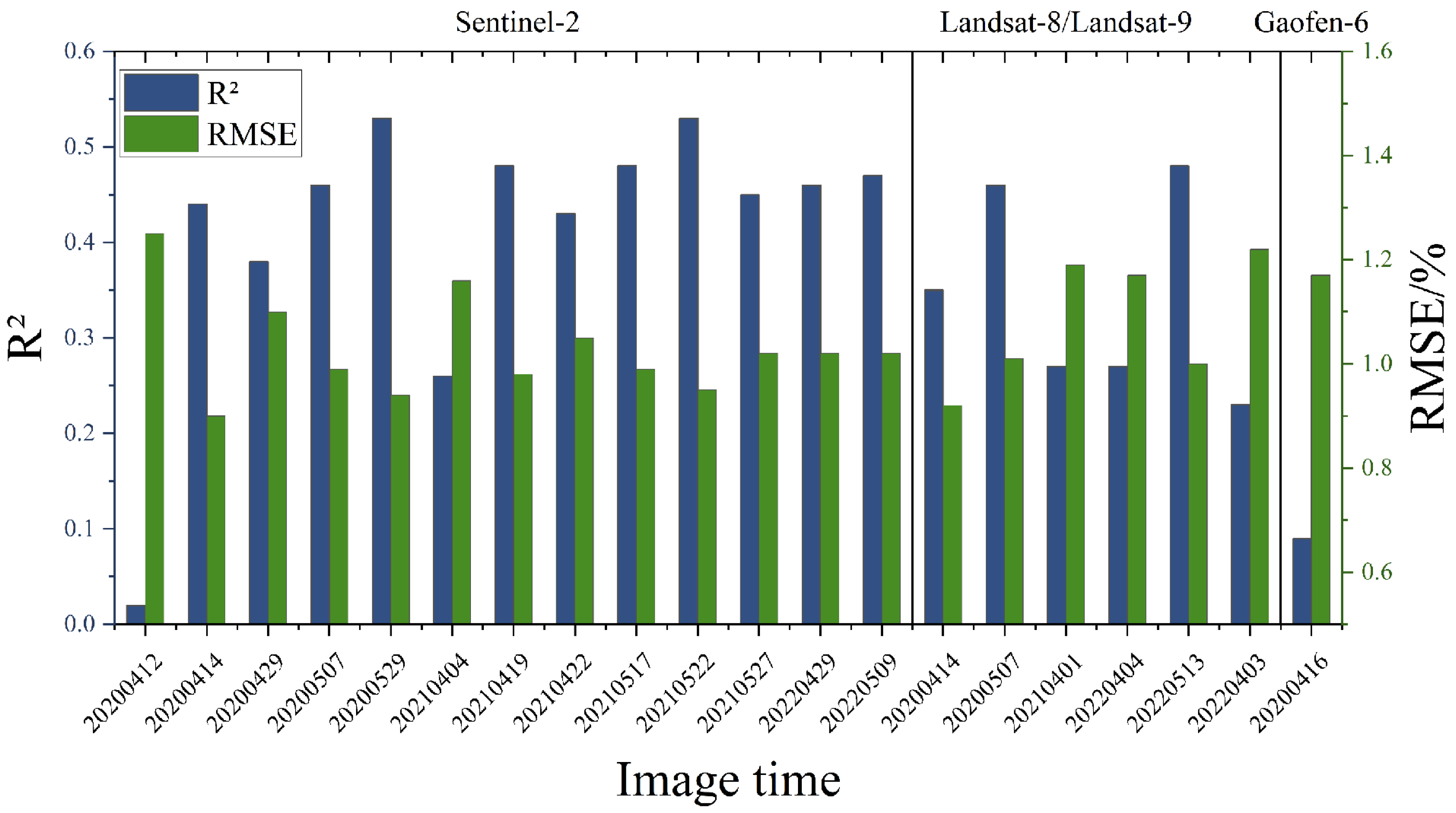

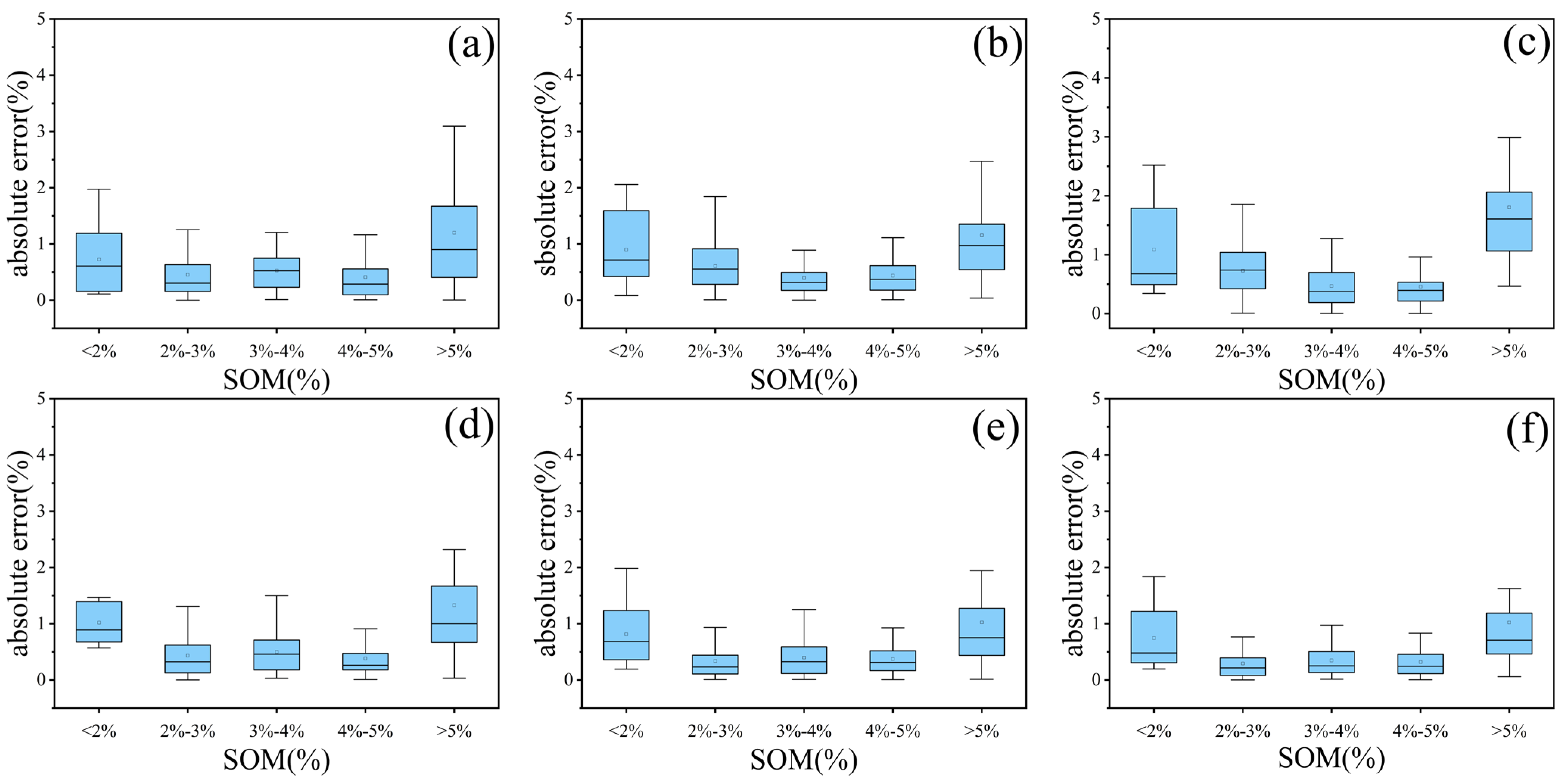
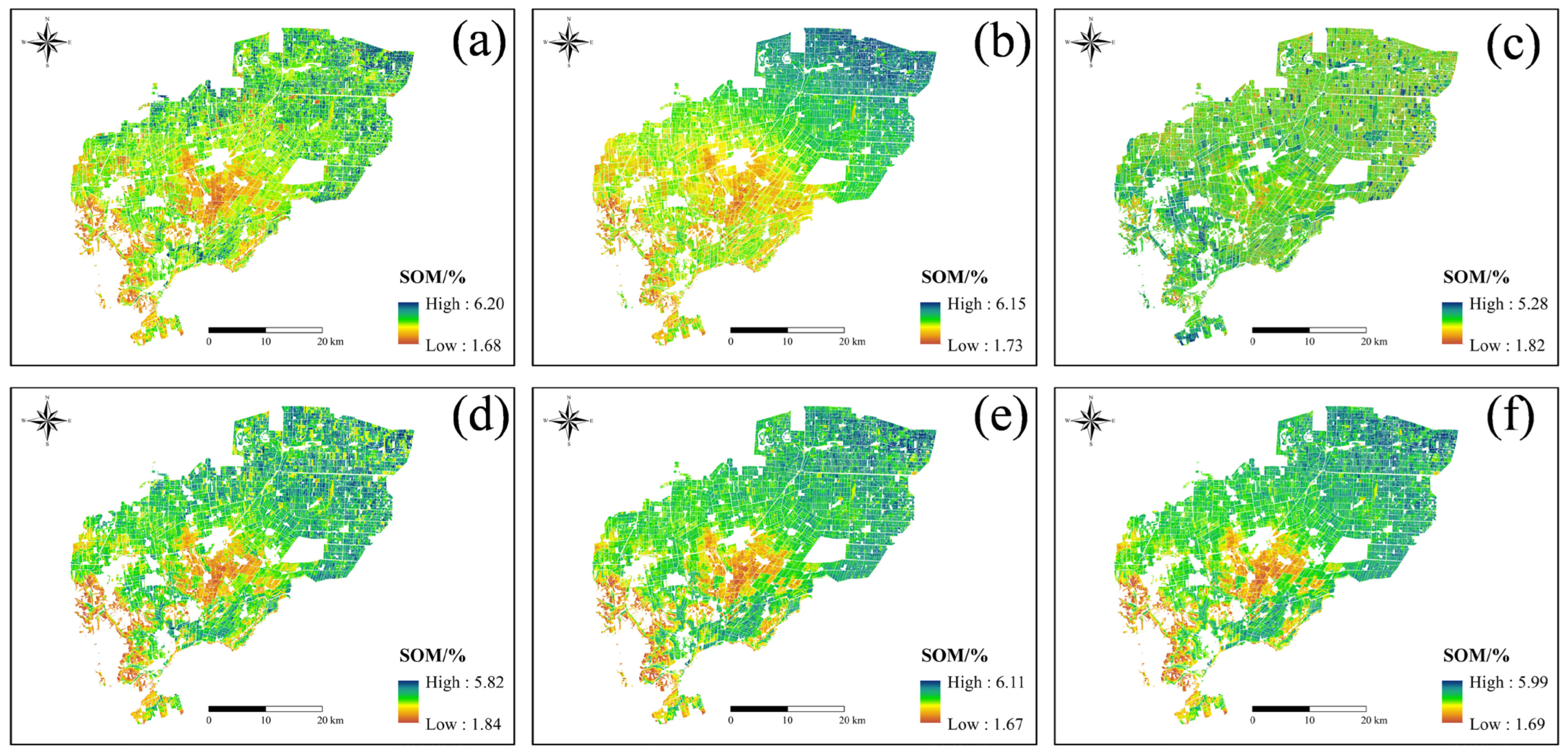

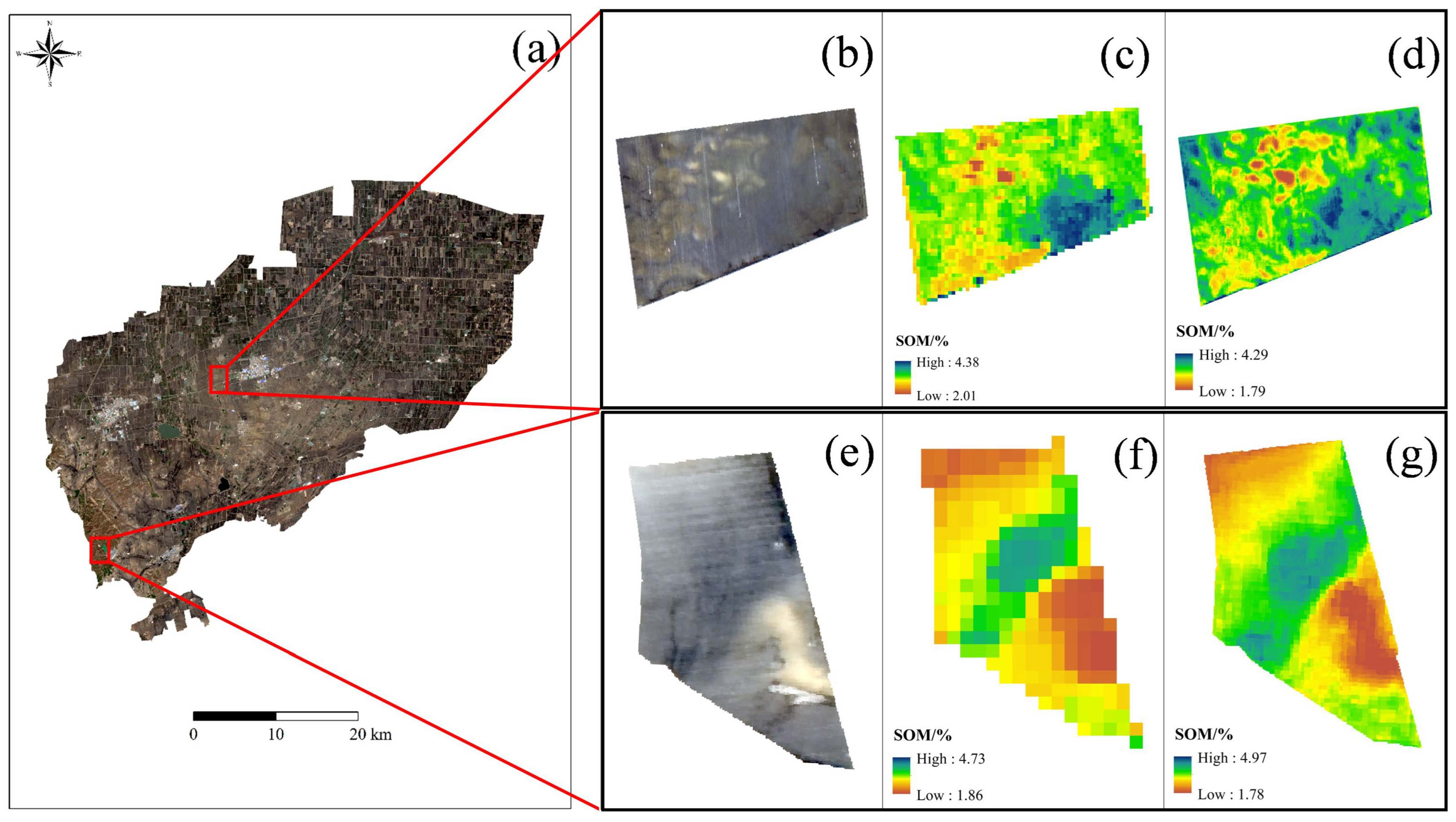
| Dataset | N | Max/% | Min/% | Mean/% | SD/% |
|---|---|---|---|---|---|
| Whole set | 279 | 6.98 | 0.48 | 3.81 | 1.21 |
| Training set | 186 | 6.98 | 0.48 | 3.81 | 1.21 |
| Validation set | 93 | 6.80 | 0.53 | 3.81 | 1.22 |
Disclaimer/Publisher’s Note: The statements, opinions and data contained in all publications are solely those of the individual author(s) and contributor(s) and not of MDPI and/or the editor(s). MDPI and/or the editor(s) disclaim responsibility for any injury to people or property resulting from any ideas, methods, instructions or products referred to in the content. |
© 2024 by the authors. Licensee MDPI, Basel, Switzerland. This article is an open access article distributed under the terms and conditions of the Creative Commons Attribution (CC BY) license (https://creativecommons.org/licenses/by/4.0/).
Share and Cite
Ma, Q.; Luo, C.; Meng, X.; Ruan, W.; Zang, D.; Liu, H. High Spatiotemporal Remote Sensing Images Reveal Spatial Heterogeneity Details of Soil Organic Matter. Sustainability 2024, 16, 1497. https://doi.org/10.3390/su16041497
Ma Q, Luo C, Meng X, Ruan W, Zang D, Liu H. High Spatiotemporal Remote Sensing Images Reveal Spatial Heterogeneity Details of Soil Organic Matter. Sustainability. 2024; 16(4):1497. https://doi.org/10.3390/su16041497
Chicago/Turabian StyleMa, Qianli, Chong Luo, Xiangtian Meng, Weimin Ruan, Deqiang Zang, and Huanjun Liu. 2024. "High Spatiotemporal Remote Sensing Images Reveal Spatial Heterogeneity Details of Soil Organic Matter" Sustainability 16, no. 4: 1497. https://doi.org/10.3390/su16041497
APA StyleMa, Q., Luo, C., Meng, X., Ruan, W., Zang, D., & Liu, H. (2024). High Spatiotemporal Remote Sensing Images Reveal Spatial Heterogeneity Details of Soil Organic Matter. Sustainability, 16(4), 1497. https://doi.org/10.3390/su16041497







